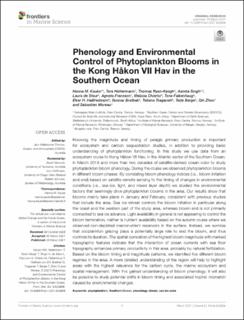| dc.contributor.author | Kauko, Hanna Maria | |
| dc.contributor.author | Hattermann, Tore | |
| dc.contributor.author | Ryan-Keogh, Thomas J. | |
| dc.contributor.author | Singh, Asmita | |
| dc.contributor.author | de Steur, Laura | |
| dc.contributor.author | Fransson, Agneta | |
| dc.contributor.author | Chierici, Melissa | |
| dc.contributor.author | Falkenhaug, Tone | |
| dc.contributor.author | Hallfredsson, Elvar H. | |
| dc.contributor.author | Bratbak, Gunnar | |
| dc.contributor.author | Tsagaraki, Tatiana Margo | |
| dc.contributor.author | Berge, Terje | |
| dc.contributor.author | Zhou, Qin | |
| dc.contributor.author | Moreau, Sebastien | |
| dc.date.accessioned | 2021-11-03T10:50:47Z | |
| dc.date.available | 2021-11-03T10:50:47Z | |
| dc.date.created | 2021-08-15T14:19:39Z | |
| dc.date.issued | 2021 | |
| dc.identifier.issn | 2296-7745 | |
| dc.identifier.uri | https://hdl.handle.net/11250/2827550 | |
| dc.description.abstract | Knowing the magnitude and timing of pelagic primary production is important for ecosystem and carbon sequestration studies, in addition to providing basic understanding of phytoplankton functioning. In this study we use data from an ecosystem cruise to Kong Håkon VII Hav, in the Atlantic sector of the Southern Ocean, in March 2019 and more than two decades of satellite-derived ocean color to study phytoplankton bloom phenology. During the cruise we observed phytoplankton blooms in different bloom phases. By correlating bloom phenology indices (i.e., bloom initiation and end) based on satellite remote sensing to the timing of changes in environmental conditions (i.e., sea ice, light, and mixed layer depth) we studied the environmental factors that seemingly drive phytoplankton blooms in the area. Our results show that blooms mainly take place in January and February, consistent with previous studies that include the area. Sea ice retreat controls the bloom initiation in particular along the coast and the western part of the study area, whereas bloom end is not primarily connected to sea ice advance. Light availability in general is not appearing to control the bloom termination, neither is nutrient availability based on the autumn cruise where we observed non-depleted macronutrient reservoirs in the surface. Instead, we surmise that zooplankton grazing plays a potentially large role to end the bloom, and thus controls its duration. The spatial correlation of the highest bloom magnitude with marked topographic features indicate that the interaction of ocean currents with sea floor topography enhances primary productivity in this area, probably by natural fertilization. Based on the bloom timing and magnitude patterns, we identified five different bloom regimes in the area. A more detailed understanding of the region will help to highlight areas with the highest relevance for the carbon cycle, the marine ecosystem and spatial management. With this gained understanding of bloom phenology, it will also be possible to study potential shifts in bloom timing and associated trophic mismatch caused by environmental changes. | en_US |
| dc.language.iso | eng | en_US |
| dc.publisher | Frontiers | en_US |
| dc.rights | Navngivelse 4.0 Internasjonal | * |
| dc.rights.uri | http://creativecommons.org/licenses/by/4.0/deed.no | * |
| dc.subject | Miljøendringer | en_US |
| dc.subject | Environmental change | en_US |
| dc.subject | Fenologi | en_US |
| dc.subject | Phenology | en_US |
| dc.subject | Sjøis | en_US |
| dc.subject | Sea ice | en_US |
| dc.subject | Planteplankton | en_US |
| dc.subject | Phytoplankton | en_US |
| dc.title | Phenology and Environmental Control of Phytoplankton Blooms in the Kong Håkon VII Hav in the Southern Ocean | en_US |
| dc.type | Journal article | en_US |
| dc.type | Peer reviewed | en_US |
| dc.description.version | publishedVersion | en_US |
| dc.rights.holder | Copyright 2021 the authors | en_US |
| dc.source.articlenumber | 623856 | en_US |
| cristin.ispublished | true | |
| cristin.fulltext | original | |
| cristin.qualitycode | 1 | |
| dc.identifier.doi | 10.3389/fmars.2021.623856 | |
| dc.identifier.cristin | 1926049 | |
| dc.source.journal | Frontiers in Marine Science | en_US |
| dc.relation.project | Norges forskningsråd: 295075 | en_US |
| dc.relation.project | Norges forskningsråd: 288370 | en_US |
| dc.relation.project | Notur/NorStore: NN9824K | en_US |
| dc.subject.nsi | VDP::Marinbiologi: 497 | en_US |
| dc.subject.nsi | VDP::Marine biology: 497 | en_US |
| dc.identifier.citation | Frontiers in Marine Science. 2021, 8, 623856. | en_US |
| dc.source.volume | 8 | en_US |

